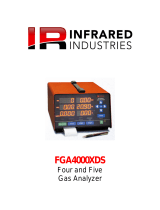Page is loading ...

October 2016
TN08 520-1007 Rev 3
Technical note
MTL gas analysers & systems
The given data is only intended as a product
description and should not be regarded as a legal
warranty of properties or guarantee. In the interest
of further technical developments, we reserve the
right to make design changes.
Eaton Electric Limited,
Great Marlings, Butterfield, Luton
Beds, LU2 8DL, UK.
Tel: + 44 (0)1582 435600 Fax: + 44 (0)1582 422283
www.mtl-inst.com
E-mail: [email protected]
© 2016 Eaton
All Rights Reserved
Publication No. TN08 520-1007 Rev 3 191016
October 2016
EUROPE (EMEA):
+44 (0)1582 723633
THE AMERICAS:
+1 800 835 7075
ASIA-PACIFIC:
+65 6 645 9888
0
5
Stoichiometric Mix
Increasing Fuel
Oxygen Concentration in Reacted Mix
Oxygen Concentration in Un-reacted Mix
Illustration for the Combustion of Methane
% Oxygen
Zones of Optimum Efficiency
0 to 2% oxygen in reacted mix
19.0 to 19.2% in unreacted mix
10
15
20
21
19
25
Figure 1 - Methane combustion
Figure 2 - Neutralisation curve
Measuring the Air/Fuel Ratio for Pre-Mix Burners
Used for Heating and Surface Treatment
When hydrocarbon fuels burn in air they do so according
to a precise chemical equation. An example of such an
equation is shown below.
This equation illustrates the combustion of methane (CH4) in air
(approximately 21% oxygen + 79% inerts).
CH4 + 2O2 + 7.52 Inerts = CO2 + 2H2O + 7.52 Inerts
Air
This equation shows amounts (volumes) of each component
required to perform a complete reaction of the methane and
air. A mix of reactants where each is in a proportion to react
completely is called a 'stoichiometric' mixture. Similar equations
can be written for other fuels.
Typically mixtures of air and gas burnt for heating etc. contain a
small amount of excess air for optimum efficiency.
Measuring and controlling the air/fuel ratio is crucial to
maintaining an efficient combustion and to create the correct
surface tension in flame treatment processes.
One way of measuring the ratio is to measure the oxygen in the
unreacted fuel air mix. For methane the oxygen concentration in
the unreacted mixture at stoichiometry would be:
2 x 100 = 19.01%
1+2+7.52
So the change in oxygen concentration from air to a stoichiometric
mixture is only 2% (21-19). Although oxygen analysers exist to
measure these concentrations, to get any appreciable accuracy
(± 0.01% at least) requires a very expensive device.
An alternative way of determining the air fuel ratio is to pre-burn a
small amount of the mixture and measure the oxygen remaining.
In this way, the difference in oxygen from air to a stoichiometric
mix is 21% - i.e. more than ten times the shift in the in-reacted
mixture. The graph above illustrates the difference.
MTL Zirconia oxygen analysers are ideal for measuring oxygen
in these combusted mixtures for two main reasons. Firstly,
they operate at elevated temperatures (600+°C/1100+°F) and
so it is not necessary to cool or otherwise condition the sample.
Secondly, they can measure the low levels of oxygen present at
stoichiometry (and beyond into the reducing zone if necessary)
with high accuracy. This equates to an accuracy in the unreacted
mixture of about ± 0.002% - significantly better than any
alternative. They measure oxygen concentration in a way
analogous to pH electrodes measuring acidity. And in a similar
way to a pH electrode being used to monitor the neutralising of an
acid by an alkali so a MTL zirconia oxygen sensor can be used to
monitor a “neutralisation” of oxygen with the fuel. The graph in
Figure 2 shows the classic 'neutralisation' curve for such a
process. The “neutralisation” point is where the reactants are in
exactly the correct proportions to produce no excess of either.
Note: The MTL Z1915C and MTL Z3000 models are used in
this type of application.
/


